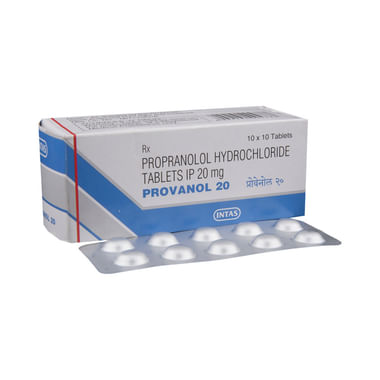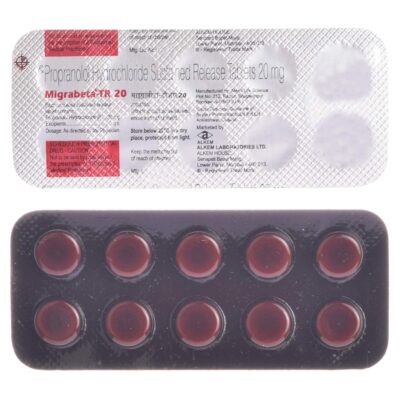💓🧠 Propranolol 20mg Tablet: A Complete Medical Overview
Propranolol 20mg is a non-selective beta-blocker medication commonly used to treat heart conditions, anxiety, and neurological disorders. By blocking the action of stress hormones like adrenaline (epinephrine) on beta-adrenergic receptors, Propranolol helps reduce heart rate, blood pressure, and symptoms associated with overactive sympathetic nervous system activity.
🔬 Mechanism of Action
Propranolol acts by blocking β1 and β2 receptors:
-
β1 receptors (in the heart): Blocking them slows the heart rate and reduces cardiac output, which lowers blood pressure and oxygen demand.
-
β2 receptors (in lungs and blood vessels): Blocking these can constrict airways and reduce tremors.
This dual action makes it effective for cardiovascular and neurological indications but requires caution in respiratory conditions like asthma.
📌 Clinical Indications
Propranolol 20mg is prescribed for several medical conditions, including:
🫀 Cardiovascular Uses:
-
Hypertension (high blood pressure)
-
Angina pectoris (chest pain due to reduced blood flow to the heart)
-
Cardiac arrhythmias (irregular heartbeat)
-
Myocardial infarction (to prevent future heart attacks)
-
Hypertrophic subaortic stenosis
🧠 Neurological and Other Uses:
-
Migraine prevention
-
Essential tremors
-
Performance anxiety / situational anxiety
-
Thyrotoxicosis (managing symptoms like palpitations)
-
Pheochromocytoma (with alpha-blockers)
-
Prevention of variceal bleeding in liver cirrhosis
💊 Dosage and Administration
-
Usual adult dose: 20mg taken 2 to 4 times a day, depending on the condition.
-
For anxiety, a single 20–40mg dose may be taken 1 hour before a stressful event.
-
The dosage may be increased or adjusted based on therapeutic response and patient tolerance.
⚠️ Never stop Propranolol abruptly, especially in heart patients, as it can lead to rebound hypertension, angina, or even heart attack.
⚠️ Precautions and Warnings
-
Asthma/COPD: Avoid, as β2 blockade may cause bronchospasm.
-
Diabetes: Can mask hypoglycemia symptoms such as fast heartbeat.
-
Bradycardia or heart block: Use with caution in patients with slow or irregular heartbeats.
-
Pregnancy and breastfeeding: Use only under medical supervision.
-
Peripheral artery disease: May worsen symptoms like cold extremities.
🤒 Possible Side Effects
Common side effects:
-
Fatigue or drowsiness
-
Cold hands and feet
-
Nausea
-
Lightheadedness
-
Vivid dreams or insomnia
Serious (rare) side effects:
-
Bradycardia (very slow heart rate)
-
Heart failure symptoms (shortness of breath, swelling)
-
Depression or mood changes
-
Bronchospasm in susceptible individuals
Seek immediate medical attention for chest pain, fainting, or difficulty breathing.
🔄 Drug Interactions
Propranolol can interact with:
-
Calcium channel blockers (e.g., verapamil, diltiazem): Increased risk of heart block or low heart rate
-
Antidiabetic medications: May mask symptoms of low blood sugar
-
Clonidine: Risk of rebound hypertension if stopped abruptly
-
NSAIDs: May reduce blood pressure-lowering effects
🧊 Storage Guidelines
-
Store at room temperature (15°C–30°C)
-
Keep away from light, moisture, and heat
-
Keep out of reach of children
📝 Conclusion
Propranolol 20mg is a widely trusted beta-blocker used for managing cardiovascular and neurological disorders. With its ability to control heart rate, reduce anxiety symptoms, and prevent migraines, it offers broad benefits. However, it must be used carefully, especially in individuals with respiratory, metabolic, or heart conduction issues. Always follow medical advice for safe and effective use.
Note: This information is intended for educational purposes and should not replace professional medical advice. Always consult a healthcare provider for personalized guidance.





Reviews
There are no reviews yet.